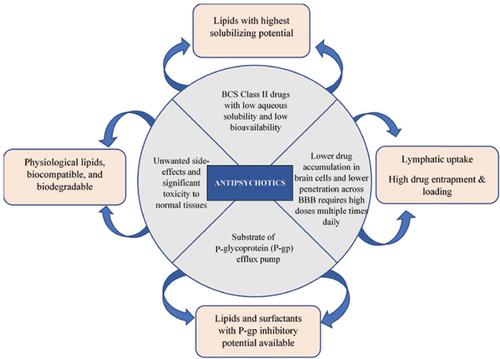Current Drug Metabolism ( IF 2.1 ) Pub Date : 2020-07-31 , DOI: 10.2174/1573399816666200627214129 Saleha Rehman 1 , Bushra Nabi 1 , Faheem Hyder Pottoo 2 , Sanjula Baboota 1 , Javed Ali 1

|
Background: Neuropsychiatric diseases primarily characterized by dementia stand third in the global list of diseases causing disability. The poor water solubility, erratic oral absorption, low bioavailability, poor intestinal absorption, and the impeding action of the blood-brain barrier (BBB) are the major factors limiting the therapeutic feasibility of the antipsychotics. Only a small percentage of antipsychotics reaches the therapeutic target site, which warrants administration of high doses, consequently leading to unwanted side-effects. Hence the main struggle for the effective treatment of neuropsychiatric diseases occurs “at the gates” of the brain, which can be mitigated with the use of a nanotechnology-based platform.
Methods: The goal of this review is to undertake a comprehensive study about the role of lipid nanoformulations in facilitating the delivery of antipsychotics across BBB along with the available in vitro and in vivo evidence.
Results: Lipid nanoformulations have attained great popularity for the delivery of therapeutics into the brain. Their nanosize helps in overcoming the biological barriers, thereby providing easy BBB translocation of the drugs. Besides, they offer numerous advantages like controlled and targeted drug release, minimizing drug efflux, long storage stability, augmented bioavailability, and reduced adverse drug effects to attain an optimal therapeutic drug concentration in the brain. Moreover, employing alternative routes of administration has also shown promising results.
Conclusion: Thus, it can be concluded that the lipid nanoformulations bear immense potential in overcoming the challenges associated with the treatment of neuropsychiatric disorders. However, the area warrants further clinical studies to ensure their commercialization, which could revolutionize the treatment of neuropsychiatric diseases in the coming decades.
中文翻译:

脂质纳米制剂治疗神经精神疾病:克服血脑屏障的方法。
背景:主要以痴呆症为特征的神经精神疾病在全球致残疾病列表中排名第三。水溶性差、口服吸收不稳定、生物利用度低、肠道吸收差以及血脑屏障(BBB)的阻碍作用是限制抗精神病药治疗可行性的主要因素。只有一小部分抗精神病药到达治疗目标部位,这需要高剂量给药,从而导致不必要的副作用。因此,有效治疗神经精神疾病的主要斗争发生在大脑的“门口”,而这可以通过使用基于纳米技术的平台来缓解。
方法:本综述的目的是对脂质纳米制剂在促进抗精神病药物通过 BBB 递送方面的作用以及可用的体外和体内证据进行全面研究。
结果:脂质纳米制剂在将治疗药物输送到大脑方面已广受欢迎。它们的纳米尺寸有助于克服生物屏障,从而使药物易于 BBB 易位。此外,它们具有许多优点,如受控和靶向药物释放、最大限度地减少药物外排、长期储存稳定性、增强的生物利用度和减少药物不良反应,从而在大脑中获得最佳治疗药物浓度。此外,采用替代给药途径也显示出有希望的结果。
结论:因此,可以得出结论,脂质纳米制剂在克服与治疗神经精神疾病相关的挑战方面具有巨大潜力。然而,该领域需要进一步的临床研究以确保其商业化,这可能会在未来几十年彻底改变神经精神疾病的治疗。










































 京公网安备 11010802027423号
京公网安备 11010802027423号